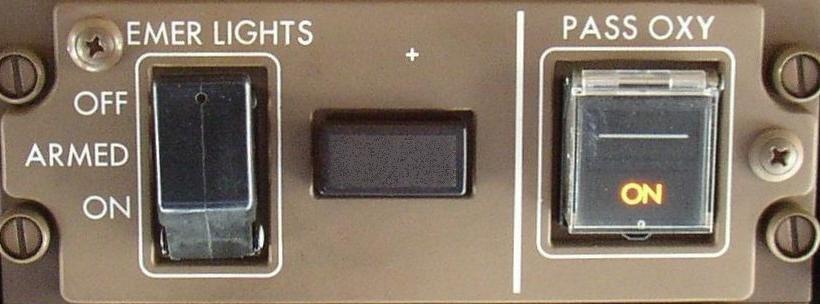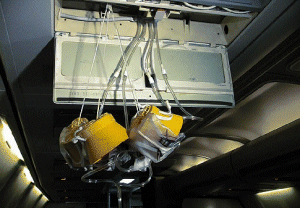Airplane General - Oxygen Systems
Amendment: Link to oxygen requirements.
- Company Limitations - Minimum Flight Crew Oxygen Quantity
- Boeing - Oxygen Requirements
- Flight Safety Foundation - Surviving Cabin Decompression
 52Kb
52Kb
Two independent oxygen systems are provided, one for the flight crew and one for the passengers. Portable oxygen cylinders are located throughout the airplane for emergency use.
Flight Crew Oxygen System

The Flight Crew Oxygen System uses quick-donning masks and regulators located at each crew station. Oxygen pressure is displayed on the lower EICAS status display.
Flight Crew and observer masks and regulators are installed in Oxygen mask panels near each seat. Squeezing the red oxygen mask release levers releases the mask from the stowage. Removing the mask:
- inflates the mask harness
- momentarily displays the yellow oxygen flow indicator.
Place the mask over the head and release the levers. The harness will contract fitting the mask to the head and face.
Oxygen Cylinder
 AMM
The crew oxygen system supplies each crew station with oxygen from a pressurised cylinder on the right side of the forward cargo compartment. There is a cylinder shutoff valve, an oxygen pressure indicator, a thermal relief port, a pressure regulator connection, and an external fill port on the neck of each cylinder.
AMM
The crew oxygen system supplies each crew station with oxygen from a pressurised cylinder on the right side of the forward cargo compartment. There is a cylinder shutoff valve, an oxygen pressure indicator, a thermal relief port, a pressure regulator connection, and an external fill port on the neck of each cylinder.
Overboard Vent
If the crew oxygen cylinder becomes over-pressurised, a thermal relief disk on the cylinder neck breaks. The high pressure oxygen flows through an overboard vent line to the overboard vent. When pressure in the vent line reaches about 500 psi, a green disk in the overboard vent is blown out and the oxygen is vented to the air. The disk is held in place by a snap-ring. The overboard vent is just aft of the forward cargo door on the lower right side of the fuselage. The green disk is easily seen during the pre-flight check.Oxygen Mask Panel
Oxygen Flow Indicator
- Shows a yellow cross when oxygen flowing.

RESET/TEST Switch
- PUSH - With the left door closed and the Oxygen ON indicator not, turns Oxygen ON momentarily to test regulator.
Normal/100% Switch
- N - Supplies an Air/Oxygen mixture on demand (the ratio depends on cabin altitude).
- 100% - Supplies 100% Oxygen on demand.

Oxygen Mask Emergency/Test Selector
- ROTATE - Supplies 100% oxygen under positive pressure at all cabin altitudes (protects against smoke and harmful vapours).
- PRESS TO TEST - Tests the positive pressure supply to the regulator.
Passenger Oxygen System

 The Passenger Oxygen System is supplied by individual chemical oxygen generators. The oxygen system provides oxygen to the passenger, attendant stations and lavatory service units. The passenger oxygen masks and chemical oxygen generators are located above the passenger seats in Passenger Service Units (PSUs). Oxygen flows from a PSU generator when any mask hanging from that PSU is pulled. When the mask is pulled to the face, the firing pin is released and strikes the primer. This starts the ignition process inside the generator. Ten seconds later oxygen flows to each mask connected to that particular generator.
The Passenger Oxygen System is supplied by individual chemical oxygen generators. The oxygen system provides oxygen to the passenger, attendant stations and lavatory service units. The passenger oxygen masks and chemical oxygen generators are located above the passenger seats in Passenger Service Units (PSUs). Oxygen flows from a PSU generator when any mask hanging from that PSU is pulled. When the mask is pulled to the face, the firing pin is released and strikes the primer. This starts the ignition process inside the generator. Ten seconds later oxygen flows to each mask connected to that particular generator.
The masks drop automatically from the PSUs if Cabin Altitude exceeds 14,000 ft.
The passenger masks can be manually deployed from the flight deck by pushing the Passenger Oxygen Switch. The Passenger Oxygen ON light illuminates and EICAS advisory message PASS OXYGEN ON displays when the system is activated.
![]() Selected ON - The passenger cabin oxygen masks drop.
Selected ON - The passenger cabin oxygen masks drop.
The passenger oxygen system is operating and the masks have dropped.
Note: Powered by the Hot Battery Bus, the Passenger Oxygen switch is live at all times.